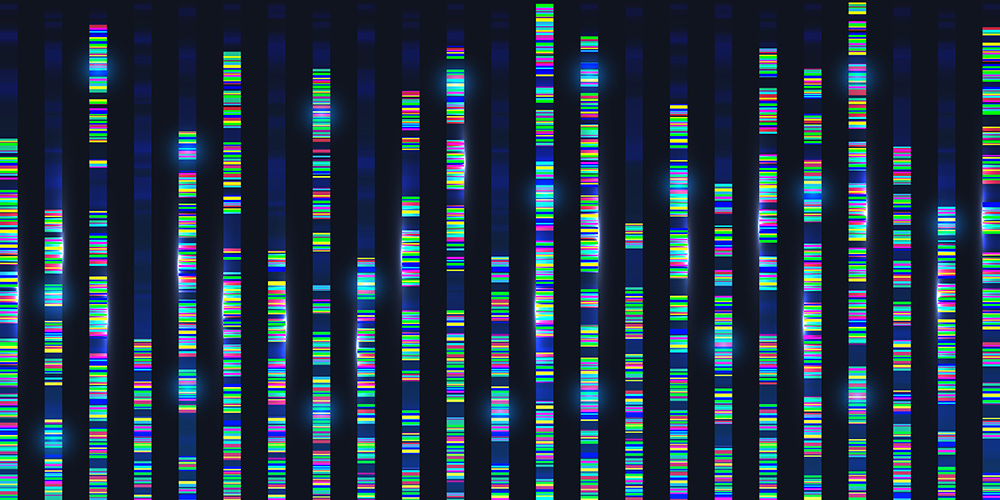


Microarray testing is ordered when someone 'usually an infant' is found to have developmental delay, intellectual disability, autism, or at least two congenital abnormalities and a diagnosis of the cause cannot be made from the information available from clinical examination, imaging studies and other blood tests. This information can be used to help decide on the level of risk of the same clinical symptoms occurring in subsequent pregnancies.
Because the test can detect very small changes - and we all have some CNVs - it may not be clear if the changes that are seen are the cause of the clinical symptoms. In that case, blood samples from both parents may be taken to see if the finding is also present in one or other parent.
The genome is the term used to describe all the genetic information in a person or other living organism. The information is in the form of DNA, which is stored in tightly packed bundles in chromosomes. These are found in the nucleus of your cells. Chromosomes are normally present in 23 pairs, with a total of 46 chromosomes in each cell. We get one copy of each chromosome from our mother in the egg and the other copy from our father in the sperm.
Chromosomal changes can occur during the formation of egg or sperm cells, in the early stages of the unborn baby's development or after birth. Pieces of DNA can be rearranged within one chromosome or transferred between two or more chromosomes. Small pieces of DNA may be lost, or an extra copy added, resulting in too little or too much genetic information. Some can cause health and developmental problems, while others may have no effect on a person's health.
These changes are called copy number variations or CNVs. Larger CNVs can be detected visually by looking at the chromosome under a microscope (see Chromosome studies) but many are too small to see. In this situation, a chromosomal microarray test is performed.
A genome-wide chromosomal microarray (CMA) test is used to detect CNVs in someone's DNA. These are changes that can cause a gain of chromosomal material (duplication) or a loss of material (deletion).
CNVs can range in size from very small pieces of DNA to large parts of a chromosome or even the loss or gain of an entire chromosome. The CNVs may contain no genes or genes that are important for development. If the detected CNV has previously been reported and classified by a number of laboratories, it may be described as benign, pathogenic, or a CNV of uncertain clinical significance.
The microarray test uses thousands of small pieces of labelled DNA that binds along the DNA in the chromosomes and the pattern generated is compared to a normal pattern. Because there are thousands of markers across each chromosome the test can detect very small losses or duplications.
The genetics specialists interpreting the test will look at the case reports to see if the changes found are known to be associated with the problems the patient is having. They will also take into consideration the genes known to be located within the copy number variant segment that has been found. In many cases the same results have been seen previously in other patients and the test result will allow the doctors to make a diagnosis. The CNV will be reported as either pathogenic or likely pathogenic, depending on the available level of evidence.
Sample
The test uses DNA which is extracted from the white cells found in blood. A conventional blood sample from the arm is required.
Any preparation?
None
Reading your test report
Microarray reports will typically be complex and require interpretation by your doctor. The three main possible findings will be:
1. No copy number variant is found. This is the most common result and it means that the patient's clinical findings remain unexplained by this test. It does not definitely mean that the cause of the condition is not genetic but with the current technology it was not identified.
2. A copy number variant has been found and is known to cause the condition.
3. A copy number variant has been found but its significance is unknown or uncertain. In this case, it is common to test the parents. If one parent has the variant and similar clinical features as the child, then the variant is likely to be responsible. If one parent has the variant and doesn't have similar features as the child, then the variant is unlikely to be responsible. If the variant is not seen in either parent, the new variant (called de-novo) may be the cause, or the condition may simply be a benign change in the DNA. If the laboratory is not sure if the CNV is the cause of the clinical symptoms, then it will be reported as a variant of uncertain significance.
The choice of tests your doctor makes will be based on your medical history and symptoms. It is important that you tell them everything you think might help.
You play a central role in making sure your test results are accurate. Do everything you can to make sure the information you provide is correct and follow instructions closely.
Talk to your doctor about any medications you are taking. Find out if you need to fast or stop any particular foods or supplements. These may affect your results. Ask:
It is often impossible to tell exactly when a de novo variant occurred. They can be present in a parent's egg or sperm cell but not be present in any of their other cells. They can also occur in the fertilised egg shortly after the egg and sperm cells unite.
Pathology and diagnostic imaging reports can be added to your My Health Record. You and your healthcare provider can now access your results whenever and wherever needed.
Get further trustworthy health information and advice from healthdirect.